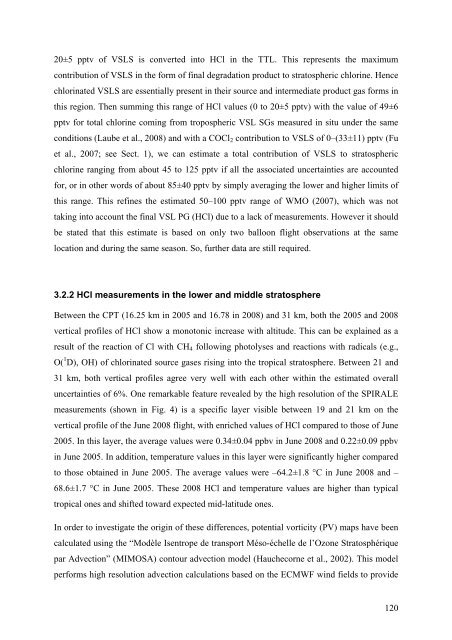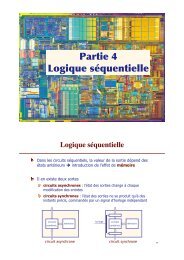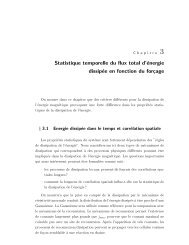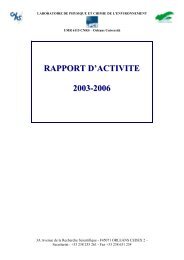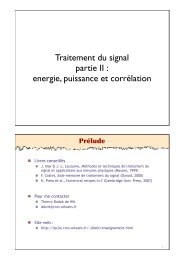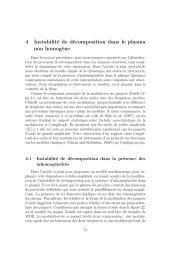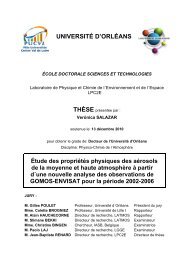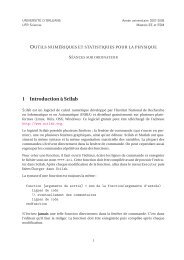UNIVERSITÉ D'ORLÉANS - Laboratoire de physique et chimie de l ...
UNIVERSITÉ D'ORLÉANS - Laboratoire de physique et chimie de l ...
UNIVERSITÉ D'ORLÉANS - Laboratoire de physique et chimie de l ...
You also want an ePaper? Increase the reach of your titles
YUMPU automatically turns print PDFs into web optimized ePapers that Google loves.
20±5 pptv of VSLS is converted into HCl in the TTL. This represents the maximum<br />
contribution of VSLS in the form of final <strong>de</strong>gradation product to stratospheric chlorine. Hence<br />
chlorinated VSLS are essentially present in their source and intermediate product gas forms in<br />
this region. Then summing this range of HCl values (0 to 20±5 pptv) with the value of 49±6<br />
pptv for total chlorine coming from tropospheric VSL SGs measured in situ un<strong>de</strong>r the same<br />
conditions (Laube <strong>et</strong> al., 2008) and with a COCl2 contribution to VSLS of 0–(33±11) pptv (Fu<br />
<strong>et</strong> al., 2007; see Sect. 1), we can estimate a total contribution of VSLS to stratospheric<br />
chlorine ranging from about 45 to 125 pptv if all the associated uncertainties are accounted<br />
for, or in other words of about 85±40 pptv by simply averaging the lower and higher limits of<br />
this range. This refines the estimated 50–100 pptv range of WMO (2007), which was not<br />
taking into account the final VSL PG (HCl) due to a lack of measurements. However it should<br />
be stated that this estimate is based on only two balloon flight observations at the same<br />
location and during the same season. So, further data are still required.<br />
3.2.2 HCl measurements in the lower and middle stratosphere<br />
B<strong>et</strong>ween the CPT (16.25 km in 2005 and 16.78 in 2008) and 31 km, both the 2005 and 2008<br />
vertical profiles of HCl show a monotonic increase with altitu<strong>de</strong>. This can be explained as a<br />
result of the reaction of Cl with CH4 following photolyses and reactions with radicals (e.g.,<br />
O( 1 D), OH) of chlorinated source gases rising into the tropical stratosphere. B<strong>et</strong>ween 21 and<br />
31 km, both vertical profiles agree very well with each other within the estimated overall<br />
uncertainties of 6%. One remarkable feature revealed by the high resolution of the SPIRALE<br />
measurements (shown in Fig. 4) is a specific layer visible b<strong>et</strong>ween 19 and 21 km on the<br />
vertical profile of the June 2008 flight, with enriched values of HCl compared to those of June<br />
2005. In this layer, the average values were 0.34±0.04 ppbv in June 2008 and 0.22±0.09 ppbv<br />
in June 2005. In addition, temperature values in this layer were significantly higher compared<br />
to those obtained in June 2005. The average values were –64.2±1.8 °C in June 2008 and –<br />
68.6±1.7 °C in June 2005. These 2008 HCl and temperature values are higher than typical<br />
tropical ones and shifted toward expected mid-latitu<strong>de</strong> ones.<br />
In or<strong>de</strong>r to investigate the origin of these differences, potential vorticity (PV) maps have been<br />
calculated using the “Modèle Isentrope <strong>de</strong> transport Méso-échelle <strong>de</strong> l’Ozone Stratosphérique<br />
par Advection” (MIMOSA) contour advection mo<strong>de</strong>l (Hauchecorne <strong>et</strong> al., 2002). This mo<strong>de</strong>l<br />
performs high resolution advection calculations based on the ECMWF wind fields to provi<strong>de</strong><br />
120


